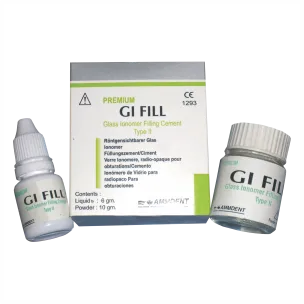Ammdent
Ammdent Gi Fill Premium GIC
Ammdent Gi Fill Premium GIC
Couldn't load pickup availability
AMMDENT GI Fill Premium GIC is a radiopaque glass polyalkenoate restorative cement meticulously engineered for a myriad of dental applications. Designed with a sophisticated chemical formulation, this dental cement exhibits exceptional adhesion to both enamel and dentine, ensuring durable and long-lasting restorations. Ideal for a wide range of dental procedures, including the restoration of deciduous teeth, repair of V-shaped defects, enamel and root erosions in the cervical area, as well as cavities with carious lesions, this premium-grade product delivers unparalleled performance and reliability. It is also suitable for fillings of class III and small fillings of class I, extended fissure sealing, and build-up fillings for crowns and linings.
The method of use is streamlined for ease and precision. With its superior adhesive properties, creation of retention is often unnecessary, although undercuts can enhance stability. The recommended layer thickness ensures optimal results while minimizing material wastage. AMMDENT GI Fill Premium GIC's liquid component is conveniently packaged with a dropper for accurate dispensing, while its powder component is designed for easy mixing. The controlled mixing time and working time ensure precise application, while the quick setting time facilitates efficient procedures.
Indication
- Restoration of deciduous teeth, particularly class 1 restorations
- Repair of V-shaped defects, enamel, and root erosions in the cervical area, including Class V fillings
- Treatment of cavities with carious lesions
- Fillings of Class III and small fillings of Class I, including extended fissure sealing and build-up fillings for crowns and linings
Features
Features
- Radiopaque glass polyalkenoate composition
- Chemical adhesion to enamel and dentine
- Versatile applications: deciduous teeth, V-shaped defects
- Quick mixing and setting times
- Minimum layer thickness of 1mm
- Convenient powder-to-liquid mixing ratio
- Pulp protection for thin dentine
Description
Description
Specification
Specification
- Composition: Radiopaque glass polyalkenoate cement
- Adhesion: Chemical adhesion to enamel and dentine
- Layer Thickness: Minimum of 1mm
- Mixing Ratio: Powder to liquid - 4.7-5.6g : 1g
- Mixing Time: 30-40 seconds
- Working Time: 2-3 minutes (at 15-23°C)
- Setting Time: Approximately 2 ½ minutes
Packaging
Packaging
- 1 x 10gms Powder
- 1 x 6gms Liquid
Direction to use
Direction to use
- Preparation: Ensure the cavity is clean and free of debris. For carious defects, prepare and clean the cavity, such as with a 3% hydrogen peroxide solution. Rinse the cavity thoroughly with water and ensure it is completely dry before proceeding.
- Adhesion Preparation: Creation of retention is generally not necessary due to the excellent adhesion of the GI Fill to dentine. However, if desired, undercuts can provide additional hold to the filling.
- Dentine Thickness Check: Assess the remaining dentine thickness. If it is more than 1-1.5 mm, additional lining is not necessary. If dentine thickness is less than 1.5 mm, consider applying a pulp protection layer with calcium hydroxide.
- Liquid Preparation: Before using the GI Fill for the first time, replace the cap with the enclosed dropper. Shake the liquid component well before use.
- Mixing: Place the powder and liquid components on a glass plate or suitable mixing pad. Gradually work the powder into the liquid using a strong plastic spatula. Use 1 drop of liquid for each level measuring scoop of powder. The recommended mixing ratio is 4.7-5.6g of powder to 1g of liquid. Mix for 30-40 seconds, ensuring thorough incorporation without exceeding 1 minute.
- Application: Dispense the mixed material into the prepared cavity immediately. Ensure the working area remains dry during the filling procedure. Class V cavities should be at least 1 mm deep.
- Setting Time: After insertion, the setting time is approximately 2 ½ minutes. Avoid disturbing the filling during this period.
- Excess Removal and Contouring: After the setting time (5-6 minutes after application), excess material can be removed with a sharp instrument. Contouring can be carried out using flexible disks. Cover the filling with varnish for protection.
- Final Polishing: For optimal results, final polishing can be done approximately 24 hours after the filling has been inserted.
- Precautions: Use pulp protection if dentine thickness is less than 1-1.5 mm. Close powder and liquid containers thoroughly after use to prevent moisture infiltration. Avoid contact with mucosa and eyes. Do not use if sensitive to ingredients or if the powder forms lumps.
Additional info
Additional info
- Manufacturer: Amrit Chemicals & Minerals Agency
- Country of Origin: India
Warranty
Warranty
- Warranty is not applicable for this product.
Product Related Questions
Product Related Questions
Question: What is Glass Ionomer Filling Cement Type II?
Answer: Glass Ionomer Filling Cement Type II is a dental restorative material known for its versatility, adhesive properties, and durability.
Question: What are the key features of Glass Ionomer Filling Cement Type II?
Answer: It features radiopacity, chemical adhesion to enamel and dentine, and a versatile application range including deciduous teeth and V-shaped defects.
Question: What is the mixing ratio for Glass Ionomer Filling Cement Type II?
Answer: The recommended mixing ratio is typically 4.7-5.6g of powder to 1g of liquid
Question: What is the setting time for Glass Ionomer Filling Cement Type II?
Answer: The setting time is approximately 2 ½ minutes after application.
Question: Is pulp protection necessary when using Glass Ionomer Filling Cement Type II?
Answer: Pulp protection is recommended for dentine thickness less than 1-1.5mm.
Question: Can Glass Ionomer Filling Cement Type II be used for Class III fillings?
Answer: Yes, Glass Ionomer Filling Cement Type II is suitable for Class III fillings and other small restorations.
Question: How should excess material be handled after application?
Answer: Excess material can be removed with a sharp instrument and contouring can be carried out with flexible disks.
Question: Is Glass Ionomer Filling Cement Type II sensitive to humidity?
Answer: Yes, Glass Ionomer Filling Cement Type II is sensitive to humidity, so it should be applied in dry conditions whenever possible.
Share


